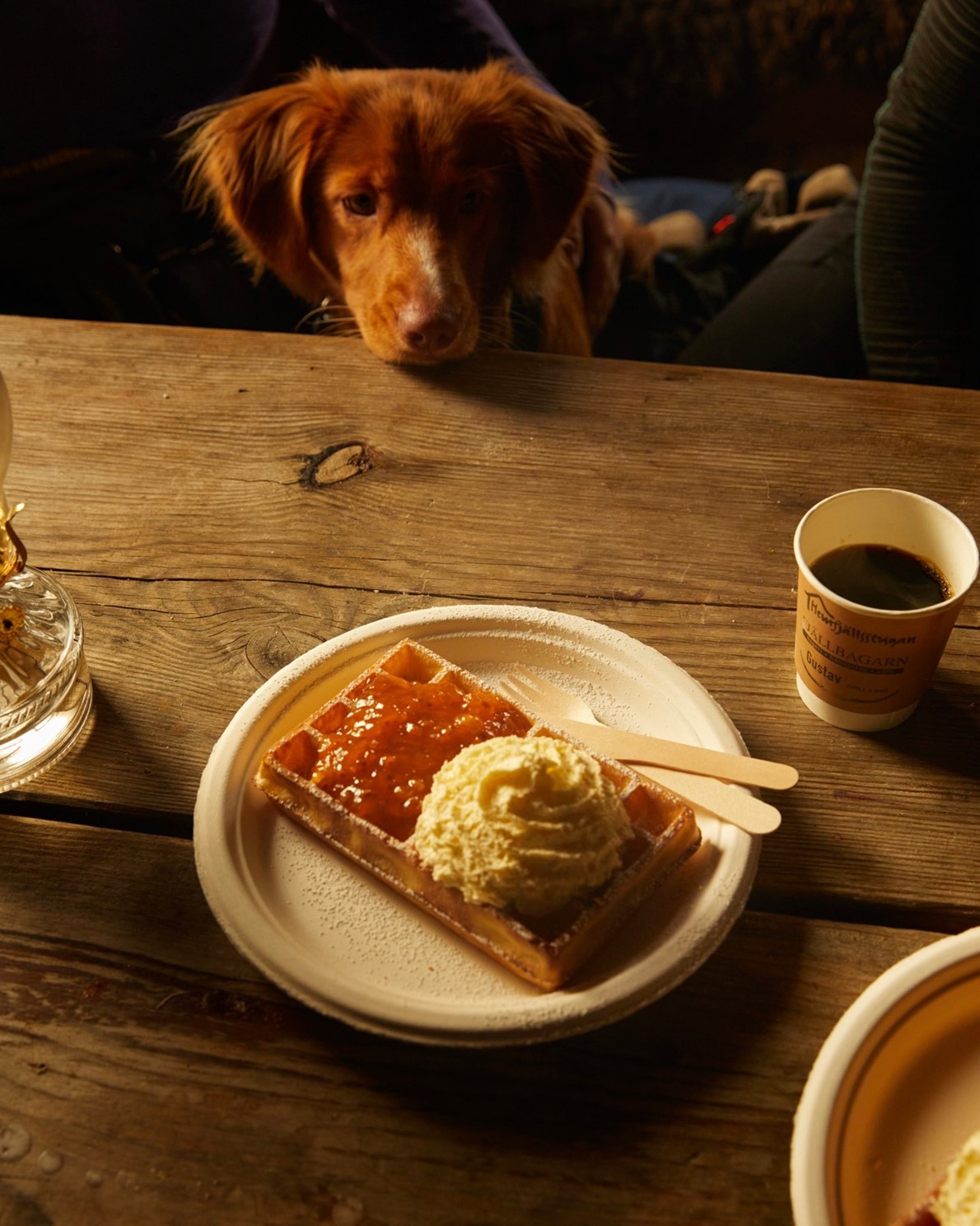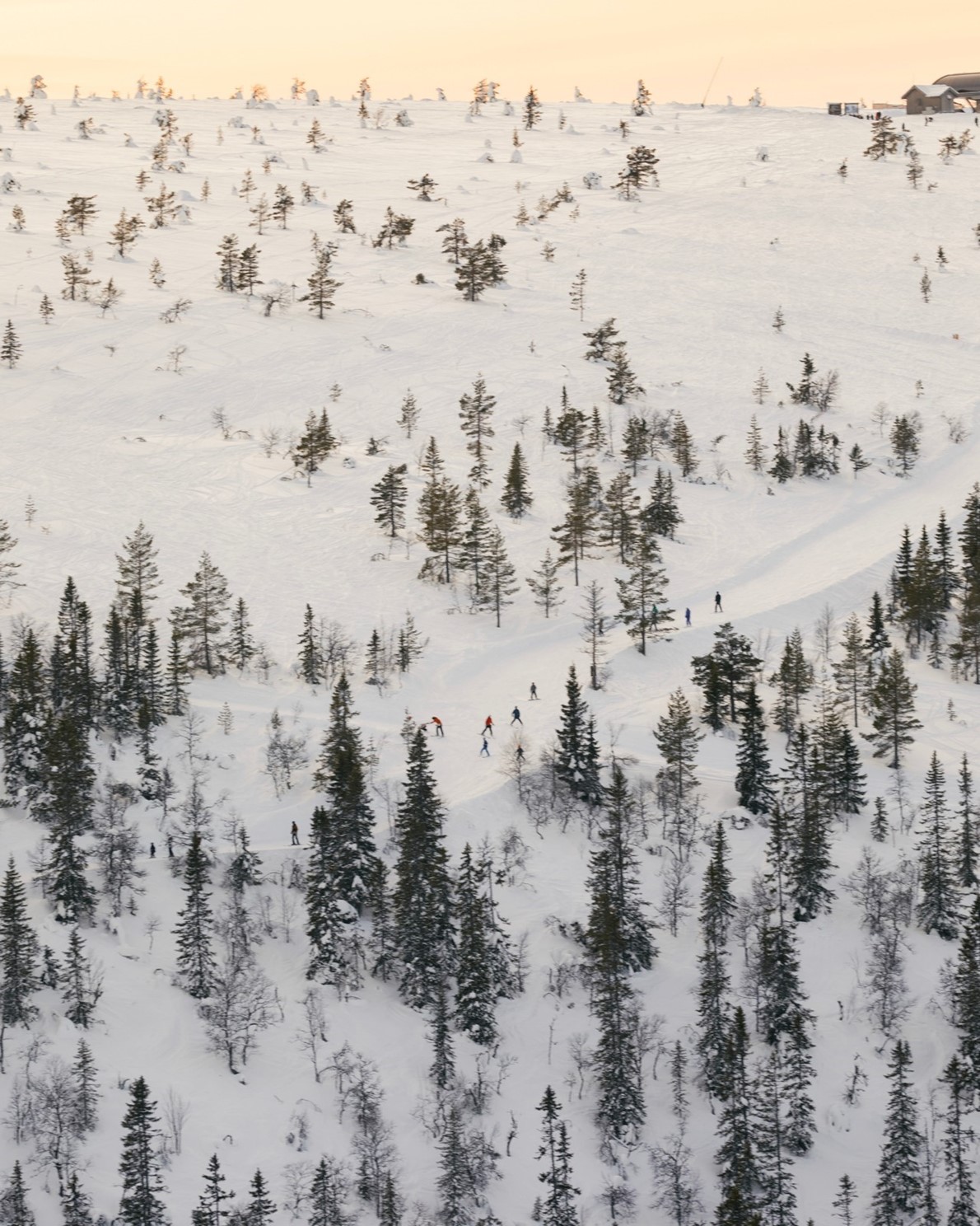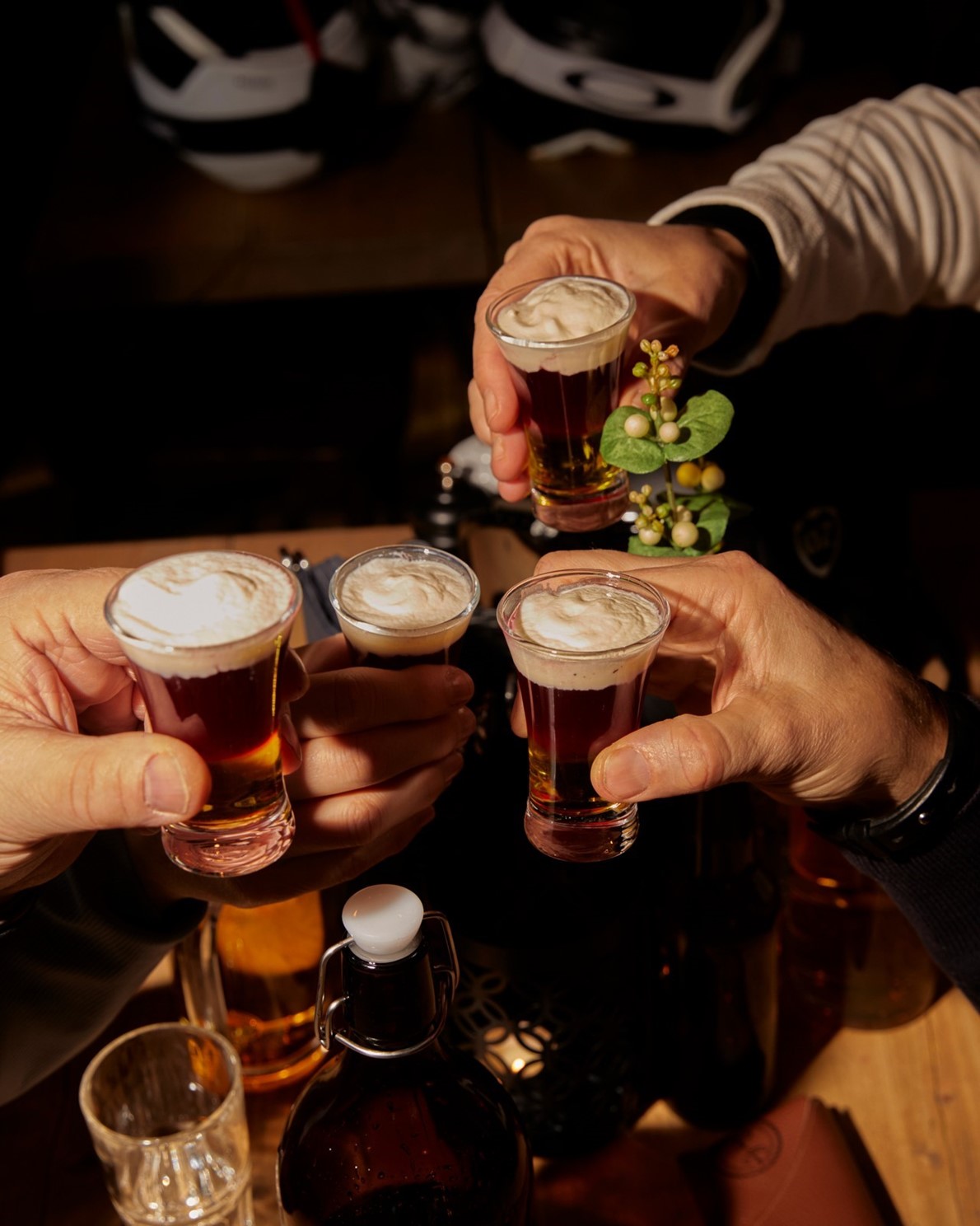Waffles, gentle slopes, and cloudberries everywhere: Skiing in Sälen, Sweden
New York Times
last updated: Feb 23,2023

Minus 24 degrees Celsius is not as
bad as it sounds.
That is what I tell my children when we board a wooden sled attached to a snowmobile and wrap ourselves in reindeer skins. If my kids hear me, they give no indication. They are buried in layers of long underwear, wool, down, more wool, probably some Gore-Tex, those foot heater things, and whatever balaclavas are made of. I cannot even see their faces. The two huddled bodies opposite me on the sled may not even be my children for all I know.
My husband, kids, and I are on our way, improbably, to taste supposedly the best waffles in the entire country of Sweden. But first you have to get there.
The waffle promised land — Hemfjällsstugan — is about 5km from the nearest road in Sälen, a town on Sweden’s western flank about five hours by car from Stockholm.
Ergo, the snowmobile. As Felix, our teenage driver, guided our sled toward Hemfjällsstugan, we zoomed into a snow squall, shapes and shadows faded into nothingness. It was like watching a painting in reverse: from depth and perspective to a seamless white void until the landscape was simply erased and you could not tell the difference between earth and sky.

Waffles with cloudberry jam and whipped cream at Hemfjällsstugan, a cabin near Sälen, Sweden, in February 2023.
It is a little troubling to not know where the ground is. After about 20 minutes, my son peeked out of his scarf long enough to tell me he was scared, and could we please go back? But then, suddenly, we had arrived at Hemfjällsstugan: a modest log cabin with a 9-meter pole with the flag of Sweden whipping around it in the icy wind — everything but Mrs Claus opening the front door wiping her hands on her apron.
On the inside, Hemfjällsstugan is lit entirely by candles and oil lamps. The dining area is a series of wooden tables and benches, a counter, and a small chalkboard menu: waffles with homemade strawberry jam, waffles with homemade blueberry jam, and waffles with homemade cloudberry jam. I think there was a soup, too.
The fires blazing in every wood stove were soon crowded with arriving skiers and snowmobilers, shedding layers, waiting to regain sensation in their extremities. Soon enough, that little cabin in the middle of the snowy woods — full of people clicking off their helmets, helping themselves to homemade kanelbullar (Swedish cinnamon and cardamom rolls) and strong coffee — swelled with the volume of happy Nordic people.

Mountains in Sälen, Sweden.
“This must be the coziest restaurant in the world,” said my daughter, a connoisseur of these things.
Swedish, through and throughBroadly speaking, Hemfjällsstugan is in the town of Sälen. I have Swedish cousins who come here every year to ski, and this year we had come to join them for a few days. The town of Sälen is not well known outside Sweden. It is not like flying to Europe to ski in Courchevel or Gstaad. On the other hand, it is only a few hours from Stockholm, Gothenberg, or in the case of my family, Jönköping — which means the place is Swedish through and through.
The whole area is called “Sälenfjällen” (which means “Sälen mountains”). There are about half a dozen ski resorts in Sälenfjällen — Stöten, Hundfjället, and Lindvallen are the ones we visited. Swedes call the whole place “Sälen” for short, the way that Californians say “Tahoe” even though there are a dozen mountains there.
Possibly the best reason to get to the top of the mountains is to eat. There is almost always a sit-down restaurant at the peak, with menus that are local, seasonal, and prepared by French-trained chefs.
“When you’re skiing all day, you want a lot of good food,” said Daniel Ahlen, head chef and owner of several restaurants in the area, including Lyktan, which sits atop Hundfjället, and Fompes Grill, which sits at the bottom of the same mountain and serves local sausages, vegan burgers, and salty fries.
Ahlen centers his menus on Swedish comfort food. “I think people would get really mad if we removed the goulash from our menu,” he said. “In Dalarna, we have our own way of doing things. Our tradition here of hunting and fishing and outdoor life are things we want to take care of and show to the rest of Sweden.” On his list: “the elk, the birds, the fish, the berries in the woods”.
About those berries. Every menu, every drinks list, every candy store (and there are a lot of them) has cloudberry something. I asked Ahlen why cloudberries have celebrity status here, and he explained that they are the pride of the forest, the rare Arctic berry. “If you serve waffles to a Swedish person who is a grown-up, you must serve it with cloudberry jam,” said Ahlen, who also owns Våffelstugen Hundfjället, a nearby cabin that specializes in waffles.
An après-ski partyA few days after our own waffle adventure, we spent a day skiing at Lindvallen, a few miles away. In the afternoon, as the sun was setting, we decided to end the day at a restaurant called Sälen Original, a log house with a high-pitched roof tucked on the side of the mountain.

Shots of schnapps are topped with whipped cream at Sälen Original in Sälen, Sweden.
Sälen Original takes après ski to a whole new and extremely Swedish level. When we walked in at around 2:45, it was silent and almost empty. A man on a plain wood stage was tuning his guitar. Then, at precisely 3pm, with theatrical precision, the door was thrown open and Swedes clomped in with their ski boots, tables filled up, and the guitarist started.
People ordered schnapps with whipped cream, shots of Jägermeister, giant steins of beer, as well as burgers, pretzels, mountains of fries, and, naturally, waffles. As the guy with the guitar began singing American rock songs and Swedish folk songs, the whole place came to life. It is a part of Swedish culture that I have always loved: the mandate that if you are eating and drinking with other people, there must be singing.
By the time we left, it was pitch black and completely silent outside. Maybe Sälen, I had started to think, claims more magic than other places. The kindly red farmhouses, the trails of chimney smoke curling upward from every village, the wise, endless forests with their precious berries, their creatures, their secrets. The warm cabins and homemade waffles hiding deep inside these woods. The whole place patrolled by elk, reindeer, the very real possibility of gnomes. There is such a sweetness to Sälen, like you have been transported into a snowy, benevolent Swedish fairy tale.اضافة اعلان
That is what I tell my children when we board a wooden sled attached to a snowmobile and wrap ourselves in reindeer skins. If my kids hear me, they give no indication. They are buried in layers of long underwear, wool, down, more wool, probably some Gore-Tex, those foot heater things, and whatever balaclavas are made of. I cannot even see their faces. The two huddled bodies opposite me on the sled may not even be my children for all I know.
My husband, kids, and I are on our way, improbably, to taste supposedly the best waffles in the entire country of Sweden. But first you have to get there.
The waffle promised land — Hemfjällsstugan — is about 5km from the nearest road in Sälen, a town on Sweden’s western flank about five hours by car from Stockholm.
Soon enough, that little cabin in the middle of the snowy woods… swelled with the volume of happy Nordic people. “This must be the coziest restaurant in the world.”A few days earlier, a woman named Cissi Bjuredahl had warned me by email that Hemfjällsstugan, which lacks electricity and water, was not exactly a restaurant. “We only serve soups, waffles & fika,” she wrote. Bjuredahl also told me the only way to get there was by snowmobile or cross-country skis. “But remember you are in the mountains, so if the weather is bad, don’t go if you haven’t tried skis before,” she had warned. And then, perhaps walking back the very Swedish honesty: “Welcome!”
Ergo, the snowmobile. As Felix, our teenage driver, guided our sled toward Hemfjällsstugan, we zoomed into a snow squall, shapes and shadows faded into nothingness. It was like watching a painting in reverse: from depth and perspective to a seamless white void until the landscape was simply erased and you could not tell the difference between earth and sky.

Waffles with cloudberry jam and whipped cream at Hemfjällsstugan, a cabin near Sälen, Sweden, in February 2023.
It is a little troubling to not know where the ground is. After about 20 minutes, my son peeked out of his scarf long enough to tell me he was scared, and could we please go back? But then, suddenly, we had arrived at Hemfjällsstugan: a modest log cabin with a 9-meter pole with the flag of Sweden whipping around it in the icy wind — everything but Mrs Claus opening the front door wiping her hands on her apron.
On the inside, Hemfjällsstugan is lit entirely by candles and oil lamps. The dining area is a series of wooden tables and benches, a counter, and a small chalkboard menu: waffles with homemade strawberry jam, waffles with homemade blueberry jam, and waffles with homemade cloudberry jam. I think there was a soup, too.
The fires blazing in every wood stove were soon crowded with arriving skiers and snowmobilers, shedding layers, waiting to regain sensation in their extremities. Soon enough, that little cabin in the middle of the snowy woods — full of people clicking off their helmets, helping themselves to homemade kanelbullar (Swedish cinnamon and cardamom rolls) and strong coffee — swelled with the volume of happy Nordic people.

Mountains in Sälen, Sweden.
“This must be the coziest restaurant in the world,” said my daughter, a connoisseur of these things.
Swedish, through and throughBroadly speaking, Hemfjällsstugan is in the town of Sälen. I have Swedish cousins who come here every year to ski, and this year we had come to join them for a few days. The town of Sälen is not well known outside Sweden. It is not like flying to Europe to ski in Courchevel or Gstaad. On the other hand, it is only a few hours from Stockholm, Gothenberg, or in the case of my family, Jönköping — which means the place is Swedish through and through.
The whole area is called “Sälenfjällen” (which means “Sälen mountains”). There are about half a dozen ski resorts in Sälenfjällen — Stöten, Hundfjället, and Lindvallen are the ones we visited. Swedes call the whole place “Sälen” for short, the way that Californians say “Tahoe” even though there are a dozen mountains there.
It is a part of Swedish culture that I have always loved: the mandate that if you are eating and drinking with other people, there must be singing.The mountains are not intimidating; they are what you would get if you sanded the top of the Alps down to smooth, endless hills. At the bottom they are blanketed in forest, but there are no trees at the summit, so you can ski down in almost every direction. The slopes are mostly gentle, and there are trails for every level skier, cross-country skier, and snowboarder.
Possibly the best reason to get to the top of the mountains is to eat. There is almost always a sit-down restaurant at the peak, with menus that are local, seasonal, and prepared by French-trained chefs.
“When you’re skiing all day, you want a lot of good food,” said Daniel Ahlen, head chef and owner of several restaurants in the area, including Lyktan, which sits atop Hundfjället, and Fompes Grill, which sits at the bottom of the same mountain and serves local sausages, vegan burgers, and salty fries.
Ahlen centers his menus on Swedish comfort food. “I think people would get really mad if we removed the goulash from our menu,” he said. “In Dalarna, we have our own way of doing things. Our tradition here of hunting and fishing and outdoor life are things we want to take care of and show to the rest of Sweden.” On his list: “the elk, the birds, the fish, the berries in the woods”.
About those berries. Every menu, every drinks list, every candy store (and there are a lot of them) has cloudberry something. I asked Ahlen why cloudberries have celebrity status here, and he explained that they are the pride of the forest, the rare Arctic berry. “If you serve waffles to a Swedish person who is a grown-up, you must serve it with cloudberry jam,” said Ahlen, who also owns Våffelstugen Hundfjället, a nearby cabin that specializes in waffles.
An après-ski partyA few days after our own waffle adventure, we spent a day skiing at Lindvallen, a few miles away. In the afternoon, as the sun was setting, we decided to end the day at a restaurant called Sälen Original, a log house with a high-pitched roof tucked on the side of the mountain.

Shots of schnapps are topped with whipped cream at Sälen Original in Sälen, Sweden.
Sälen Original takes après ski to a whole new and extremely Swedish level. When we walked in at around 2:45, it was silent and almost empty. A man on a plain wood stage was tuning his guitar. Then, at precisely 3pm, with theatrical precision, the door was thrown open and Swedes clomped in with their ski boots, tables filled up, and the guitarist started.
People ordered schnapps with whipped cream, shots of Jägermeister, giant steins of beer, as well as burgers, pretzels, mountains of fries, and, naturally, waffles. As the guy with the guitar began singing American rock songs and Swedish folk songs, the whole place came to life. It is a part of Swedish culture that I have always loved: the mandate that if you are eating and drinking with other people, there must be singing.
There is such a sweetness to Sälen, like you have been transported into a snowy, benevolent Swedish fairy tale.People ate and drank, clapped and sang along, and ordered more rounds of glögg (spiced mulled wine); kids climbed the stairs, dangling their feet off the balcony, while servers carried skis — holes drilled to hold shots of schnapps — in every direction.
By the time we left, it was pitch black and completely silent outside. Maybe Sälen, I had started to think, claims more magic than other places. The kindly red farmhouses, the trails of chimney smoke curling upward from every village, the wise, endless forests with their precious berries, their creatures, their secrets. The warm cabins and homemade waffles hiding deep inside these woods. The whole place patrolled by elk, reindeer, the very real possibility of gnomes. There is such a sweetness to Sälen, like you have been transported into a snowy, benevolent Swedish fairy tale.
Read more Lifestyle
Jordan News

